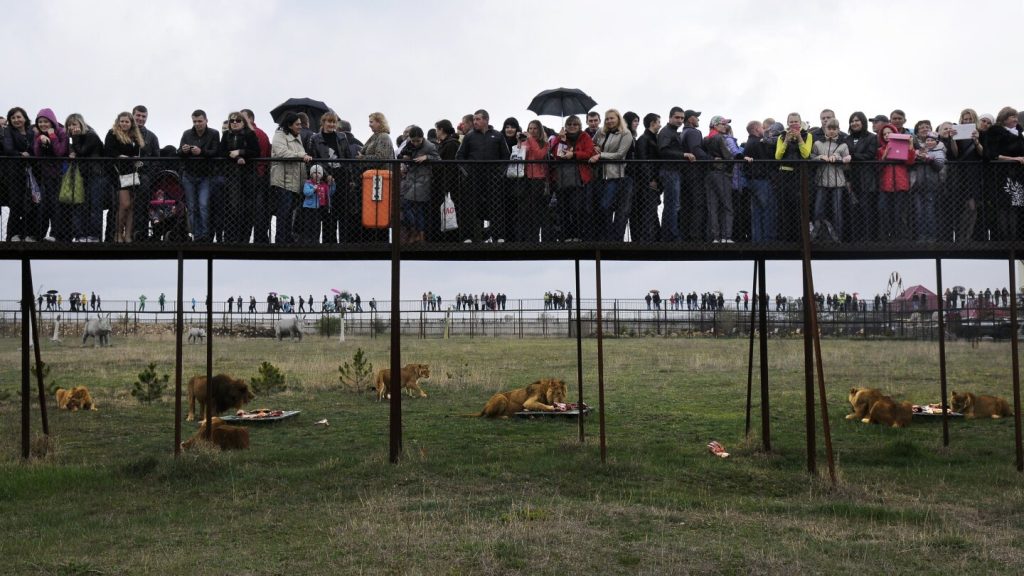The incident at the Taigan park in Crimea, where a worker was fatally attacked by lions, has sparked an investigation by the Russian Investigative Committee. The worker reportedly entered a cage to clean it without properly securing an internal door that would have kept her separate from the three lions inside. The park, located in Belogorsk, is a popular tourist attraction that houses around 60 lions in a vast area for visitors to observe. The committee has initiated a criminal case to determine whether negligence played a role in the tragic incident, although it remains unclear at this point who may be held accountable.
The news of the worker’s death at the wildlife park has raised concerns about safety measures and protocols in place to protect both employees and animals. With the park allowing visitors to observe lions roaming freely from elevated walkways, questions have been raised about the potential risks involved in such close proximity to wild animals. The tragic event serves as a reminder of the dangers inherent in working with wildlife and the importance of strict safety guidelines to prevent such incidents from occurring in the future. The investigation will aim to establish whether any lapses in security or oversight contributed to the worker’s death.
The circumstances surrounding the fatal lion attack have also highlighted the complex political context of Crimea, which was annexed by Russia from Ukraine in 2014. The majority of the international community does not recognize Crimea as part of Russia, adding a layer of complexity to the incident at the Russian-owned wildlife park. The worker’s death has drawn attention not only to the safety risks at the Taigan park but also to the broader geopolitical implications of operating in a disputed territory. As the investigation unfolds, it will be important to consider how political tensions may impact the handling of the case and any potential repercussions for the park and its management.
The tragedy at the Taigan park has underscored the need for thorough safety training and protocols for workers in wildlife parks and sanctuaries. Employees who work closely with wild animals must be equipped with the necessary knowledge and tools to ensure their own safety and that of the animals in their care. Proper procedures for entering animal enclosures, securing doors, and handling potentially dangerous situations are essential to prevent accidents and tragic incidents like the one that occurred at the park. The investigation into the worker’s death will likely focus on identifying any deficiencies in training or safety measures that may have contributed to the attack.
The incident at the Taigan park has sent shockwaves through the local community and the wildlife conservation sector, prompting calls for increased vigilance and accountability in the management of such facilities. The tragic loss of life serves as a somber reminder of the responsibilities that come with caring for wild animals and the importance of prioritizing safety in all aspects of wildlife park operations. As the investigation progresses, it is hoped that lessons will be learned from this devastating event and that measures will be taken to enhance safety standards and mitigate risks for workers and animals alike. The outcome of the investigation will be crucial in determining the factors that led to the worker’s death and in preventing similar tragedies from occurring in the future.
The worker’s death at the Taigan park is a stark reminder of the inherent dangers faced by those who work with wild animals and the need for robust safety protocols to protect both humans and animals. The incident has sparked an investigation into possible negligence and safety lapses at the park, raising broader questions about the risks associated with wildlife parks and sanctuaries. As the investigation unfolds, it will be important to consider the geopolitical context of Crimea and how it may impact the handling of the case. The tragic event has highlighted the importance of stringent safety measures in wildlife facilities and the need for enhanced training and oversight to prevent future accidents. The loss of the worker’s life is a tragedy that serves as a solemn reminder of the responsibilities that come with working with wild animals and the necessity of prioritizing safety above all else.


